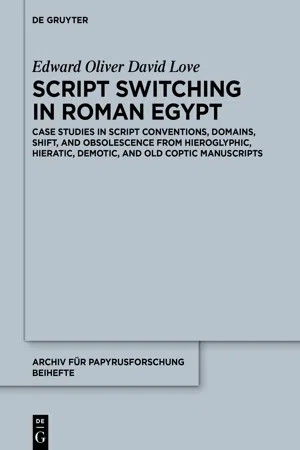
Script Switching in Roman Egypt
Case Studies in Script Conventions, Domains, Shift, and Obsolescence from Hieroglyphic, Hieratic, Demotic, and Old Coptic Manuscripts
- 415 pages
- English
- PDF
- Available on iOS & Android
Script Switching in Roman Egypt
Case Studies in Script Conventions, Domains, Shift, and Obsolescence from Hieroglyphic, Hieratic, Demotic, and Old Coptic Manuscripts
About This Book
Script Switching in Roman Egypt studies the hieroglyphic, hieratic, demotic, and Old Coptic manuscripts which evidence the conventions governing script use, the domains of writing those scripts inhabited, and the shift of scripts between those domains, to elucidate the obsolescence of those scripts from their domains during the Roman Period. Utilising macro-level frameworks from sociolinguistics, the textual culture from four sites is contextualised within the priestly communities of speech, script, and practice that produced them. Utilising micro-level frameworks from linguistics, both the scripts of the Egyptian writing system written, and the way the orthographic methods fundamental to those scripts changed, are typologised. This study also treats the way in which morphographic and alphabetic orthographies are deciphered and understood by the reading brain, and how changes in spelling over time both resulted from and responded to dimensions of orthographic depth. Through a cross-cultural consideration of script obsolescence in Mesoamerica and Mesopotamia and by analogy to language death in speech communities, a model of domain-bydomain shift and obsolescence of the scripts of the Egyptian writing system is proposed.
Frequently asked questions
Information
Table of contents
- Contents
- Acknowledgements
- Preface
- Transliteration Conventions
- Translation Conventions
- Manuscript Citation
- Glossary of Terminology
- 1 The Zenith and Nadir of Egyptian Writing
- 2. Frameworks for Studying Egyptian Priesthoods in Roman Egypt
- 3. Modelling Language Death and Script Obsolescence
- 4 Typologising Innovative Scripts and Spellings in Roman Egypt
- 5 Innovative Scripts and Spellings at Pemje/Oxyrhynchus
- 6 Innovative Scripts and Spellings at Totoun/Tebtunis
- 7 Innovative Scripts and Spellings at Timoui/Soknopaiou Nesos
- 8 Innovative Scripts and Spellings at Narmoute/Narmouthis
- 9 Script Conventions, Domains, Shift, and Obsolescence as Evidenced by the Innovative Scripts and Spellings of Roman Egypt
- Glossary
- Bibliography
- Indices